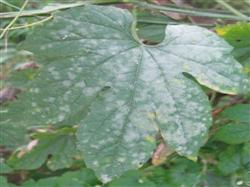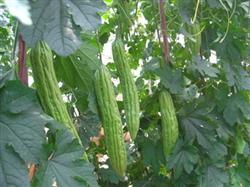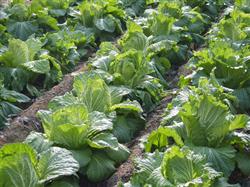Which diseases and insect pests should be controlled when planting balsam pear?

Which diseases and insect pests should be controlled when planting balsam pear? Please introduce the control methods for planting balsam pear diseases and insect pests and the following control methods: 1, powdery mildew harm symptoms: the main harm to leaves. At the initial stage of the disease, small white powder spots appeared on the front or back of the leaves, mostly on the back of the leaves, and then the disease spots gradually expanded and became a large powdery area with indistinct edges. In severe cases, the leaves are withered and yellow and become brittle and generally do not fall off. The white powder gradually turned gray and white, and finally the whole leaf became yellowish brown and dried up. Most of the diseases start from the middle and lower leaves and gradually spread to the upper leaves. Disease conditions: the pathogen of the disease is ascomycetes, which is an idiopathic parasite. The diseased seedlings overwintered with mycelium or closed capsule on the host or on the diseased body, or on crops such as cucumbers in greenhouse. Germs are mainly transmitted by air and running water. The epidemic temperature in the field is 16 ℃ ~ 24 ℃. The range of adaptation to relative humidity is wide, the disease occurs quickly when the air humidity is between 45% and 75%, and the development of the disease is obviously inhibited when the air humidity is more than 95%. The disease is generally mild in years with less rainfall. In case of continuous cloudy and muggy weather, the disease develops rapidly. Overgrown plants, dense vine leaves, poor ventilation and light transmission, etc., are easy to lead to the occurrence of powdery mildew. Prevention and control measures: ① strengthen cultivation management, pay attention to the cultivation of strong seedlings, reasonable close planting, timely pruning and leafing, improve ventilation and light transmission conditions, make the plant grow healthily and improve the ability of disease resistance. The base fertilizer needs to be increased by applying phosphorus and potassium fertilizer to prevent excessive application of nitrogen fertilizer during the growth period. In the physical control of ②, 27% high-fat emulsion was sprayed on the leaves at the initial stage of the disease to form a thin film, which could not only prevent bacteria from invading people, but also cause the death of powdery mildew under anoxic conditions. It is generally sprayed once every 5 days and 4 times in a row. ③ biological control spray 2% agricultural antibiotic 120 water agent, once every 6-7 days, the control effect is more than 90%. The agents that can be alternately sprayed with ④ are as follows: 15% triadimefon wettable powder 1500 times, 30% Teflin wettable powder 1500 × 2000 times, 40% polysulfide suspensions 500 times 600 times, 50% sulfur suspensions 250 times 300 times, 50% Dysenamine aqueous solution 1000 times, 47% Ruinong wettable powder 600 times 800 times, 77% can kill 500 times 700 times of wettable powder. Smoking with chlorothalonil or sulfur smoke in protected areas can treat both downy mildew and powdery mildew. The technical points of chemical control are: early prevention, spray cycle, large amount of water. Spray evenly on the middle and lower old leaves and the back of the leaves. In the initial stage of the disease, spraying once every 7-10 days and spraying 2-3 times continuously, a better control effect can be obtained. 2. Symptoms of blight damage: balsam pear blight usually appears before flowering. Both stems and fruits are susceptible to disease. The leaves lost their luster at first, and at the initial stage they were dark green water-stained spots with irregular shape and inconspicuous edge. a thin layer of white mold could be seen when the humidity was high, and it was bluish white and easy to break when dry. The petiole and vine node appear dark green water-stained soft rot, and the affected part is easy to overflow and shrink. Melon strips are damaged by dark green sunken disease spots, when the humidity is high, melon strips quickly soft rot, suffer from sparse white mold, rot and stink. Disease condition: it is a fungal disease caused by Phytophthora. The pathogen overwintered in the soil with mycelium, chlamydospore and oospore. The germs on the disease spot spread through watering, rain splash, air flow and so on. The optimum temperature of pathogen was 27 ℃ ~ 31 ℃, the highest was 37 ℃ and the lowest was 5 ℃. Water is needed for sporangia to release zoospores. Low temperature, overcast and rain or high temperature and high humidity are conducive to bacterial infection, and the incubation period is short, only 3-4 days, which usually occurs from August to September. Before drought and after rain or when the fruit is poured into the growing period, the soil water content suddenly increases, which is easy to cause disease. The disease is serious in low-lying, poor drainage and continuous cropping land. Control measures: ① agricultural control: crop rotation for more than 3 years. High ridge (ridge) cultivation covered with plastic film was used to reduce the pathogen of water splashing on the ground. Reasonable irrigation and control of field humidity. Proper control of watering in the rainy season, timely drainage after rain, so that the rain is dry. Timely watering in the morning, flooding is strictly prohibited when watering, and should be carried out in the afternoon or evening on a sunny day. More application of organic fertilizer can promote plant growth, deep roots and luxuriant leaves, and improve resistance. Plant adjustment should be carried out in time to prevent overdense growth and poor ventilation and light transmission. Remove the diseased leaves and burn them at any time. ② medicine prevention and cure: choose 25% Ridotoxin wettable powder 800 × 1000 times, 80% Dysen zinc wettable powder 600 times, 64% alum wettable powder 500 times, 40% aluminum ethyl phosphate wettable powder 300 times 400 times, 80% Xinwansheng wettable powder 500 times 600 times, 72.2% Purek water 400 times, 50% potassium cream copper wettable powder 600 times alternately Spray once every 5 to 10 days for 3 times in a row. Spray should be thoughtful and meticulous, and all leaves, fruits and nearby ground should be sprayed. 3. Downy mildew: both seedling stage and adult stage can be damaged. It mainly harms leaves, stems, tendrils and pedicels. When the disease occurs in the seedling stage, the irregular chlorotic and withered macula is produced on the front of the cotyledons, and the gray-black mildew layer is produced on the back of the leaves when it is wet, and when it is serious, the cotyledons turn yellow and dry. In the adult stage, the disease usually starts from the lower leaves and gradually spreads upward. At the beginning of the disease, there were water-stained light green or yellow spots on the front of the leaf, and then gradually expanded, from yellow to light brown, and polygonal spots were formed by the vein limit of the leaves. A purple-gray mildew layer was formed at the diseased spot on the back of the leaf. Under moist conditions, the mildew layer becomes thicker and black. In severe cases, the disease spots are connected into pieces, the whole leaves are yellowish brown, dry and curled, and the leaves of the whole plant die. At the initial stage of the disease, 25% Ruidui wettable powder 800 × 1000 times, or 40% ethyl phosphorus aluminum wettable powder 300 times, or 75% chlorothalonil wettable powder 600 times 800 times, or 65% Dysen zinc wettable powder 400 times 500 times, or 58% Ruidui manganese zinc 600 times, or 64% alum rice 400 times. One of the above-mentioned drugs should be sprayed for 3 times every 7 to 10 days. 4. Melon fruit fly: melon fruit fly, also known as "needle bee", melon maggot, etc., which belongs to the pest of Diptera Muscidae. The larvae are mainly harmed. First, the adults pierce the oviposition tube into the young melon epidermis to lay eggs, and the larvae hatch and drill into the melon meat to feed. The injured melons turn yellow at first, and then the whole melons rot and stink. Make a large number of plants fall melon. Even if the melon does not rot, the stab wound condenses with glue, deformly sinks, the pericarp hardens, and the bitter quality decreases. Prevention and control methods: first, timely removal of the injured melon, and spraying and deep burying; second, in serious cases, bagging the young melon to avoid adult spawning. In the period of high incidence of adults, poison bait can be used to trap and kill adults, 40 banana peels + 90% trichlorfon crystals + 1 essence, or 1.8% avermectin ointment 1500 times + Lushudan 1500 times (4.5m E) emulsion control, even spray twice, the effect is also good. Or spray the plant with 1000 times of 50% dichlorvos EC and 2.5% deltamethrin 3000 times, once every 3-5 days, for 2 times. It is effective to control adults. Young melons are protected by paper bags to prevent adults from spawning. Remove the injured melon and destroy it. It can also be hung between the lines with sticky fly paper, and it also has a certain effect. 5. Melon borer: Chilo suppressalis belongs to the family Lepidoptera. The plant was harmed by the larvae. At the initial stage, the larvae ate the mesophyll on the back of the leaves, showing gray spots. After three years of age, the leaves or tender shoots are sewn together and live in them to feed, so that the leaves are perforated or engraved. When serious damage is done, only the veins are left. The larvae often eat into the melon and feed on the melon meat, which affects the yield and quality. Control methods: clean the fallen leaves of residual plants in the countryside, eliminate overwintering pupae and reduce the source of insects. In the larval stage, 20% fenvalerate 3000 times or 50% malathion 1000 times can be used to spray plants with high control effect. 6. Ground tigers: ground tigers belong to the family Lepidoptera. There are many species of ground tigers. There are three common species in China: small land tigers, yellow land tigers and earth tigers. Among them, the small land tiger is a major pest in the world, and it is the most widely distributed. Poisonous weeds: 50 grams of 90% trichlorfon, evenly mix 30-40 kilograms of chopped fresh grass, add a small amount of water, and scatter larvae near the vegetable field in the evening. For chemical control of ground tiger larvae before the 3rd instar, 2.5% trichlorfon powder is sprayed with 22.5-30kg of trichlorfon powder per hectare, or poisonous soil is made of 150kg fine soil and scattered around the plant, or 1000 times of 80% trichlorfon wettable powder is used, or 50% phoxim EC is used for ground spray, or 20% fenvalerate EC is used for ground spray. When the insect age is older, 50% phoxim EC or 80% dichlorvos EC 1000-1500 times solution can be used to irrigate the root and kill the larvae in the soil. 7. Melon aphid: melon aphid is also called cotton aphid, commonly known as honey worm, greasy insect and so on. It belongs to Homoptera and Aphididae. The adults and nymphs of melon aphids are parasitic on the back of the host leaves or on the tender shoots and suck sap with oral needles. Especially like to gather to feed on the tender stems of young leaves, causing the leaves to shrink, deform and curl to the back. After the plant was damaged, the growth and development was stagnant or slow, and the yield and quality were reduced. Melon aphid is also the main transmission vector of virus disease, and virus disease is one of the main diseases of melon vegetables at present. Therefore, if the damage of melon aphid is light, the yield will be reduced, and if it is heavy, there will be no yield. Melon aphids also excrete honeydew, pollute leaves and products, and reduce product quality. At present, the control of aphids is mainly chemical control. In chemical control, it should be based on the principle of early prevention. The commonly used drugs are: 50% aphid mist wettable powder or water dispersible granule 2000-3000 times liquid, which has special effect on vegetable aphid and does not hurt natural enemies; or 40% dimethoate EC 1000-1500 times liquid; or 70% aphid pine wettable powder 2500 times liquid and so on. Vegetable aphids are prone to resistance to pyrethroid pesticides and should be used with caution or mixed with other pesticides, such as 2.5% cypermethrin EC 3000-4000 times, or 10% cypermethrin EC 2000-6000 times, which are commonly used. It can also be prevented by 1500 times of 1.8% avermectin ointment and 1500 times of imidacloprid wettable powder. Click to get more balsam pear planting techniques click to get more vegetable planting techniques
- Prev

How to plant balsam pear?
How to plant balsam pear? Please introduce the planting method of balsam pear can refer to the following methods: 1. Cultivation season. Green balsam pear can be cultivated in spring, summer and autumn in southern China. Spring sows from December to March and harvest from April to July; summer sows from April to May and harvest from June to September; autumn from July to September.
- Next

What do you need to pay attention to when planting summer cabbage?
What do you need to pay attention to when planting summer cabbage? Summer cabbage is a kind of Chinese cabbage which comes into market between summer and autumn. However, due to the high summer temperature and more rain, it is the season with high incidence of diseases and insect pests. When planting Chinese cabbage, we must grasp the key links, and we must select the right varieties and take appropriate management measures in order to achieve stability.
Related
- Where is it suitable to grow horseradish in China? it is expected to see the middle altitude horseradish in Alishan.
- How to prevent tomato virus disease reasonably? (Control methods included)
- Many people like to plant towel gourd on the balcony. What are the main points of this method and management?
- What crops can chili peppers be mixed with?
- Fertilization techniques and matters needing attention in Tomato
- What are the grafting techniques for peach seedlings in spring?
- Harm and control methods of root swelling disease of Chinese cabbage
- What are the pests of sweet potatoes? How to prevent and cure it?
- Symptoms, causes and Control methods of navel Rot in Tomato
- The cause of "Cucumber rotten bibcock" in Farmers' planting Cucumber and its Control Plan

